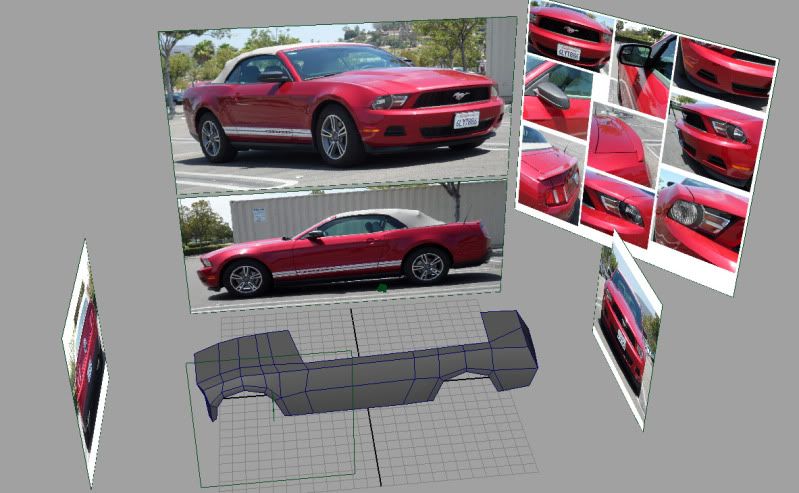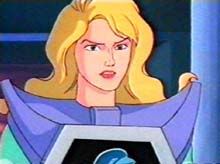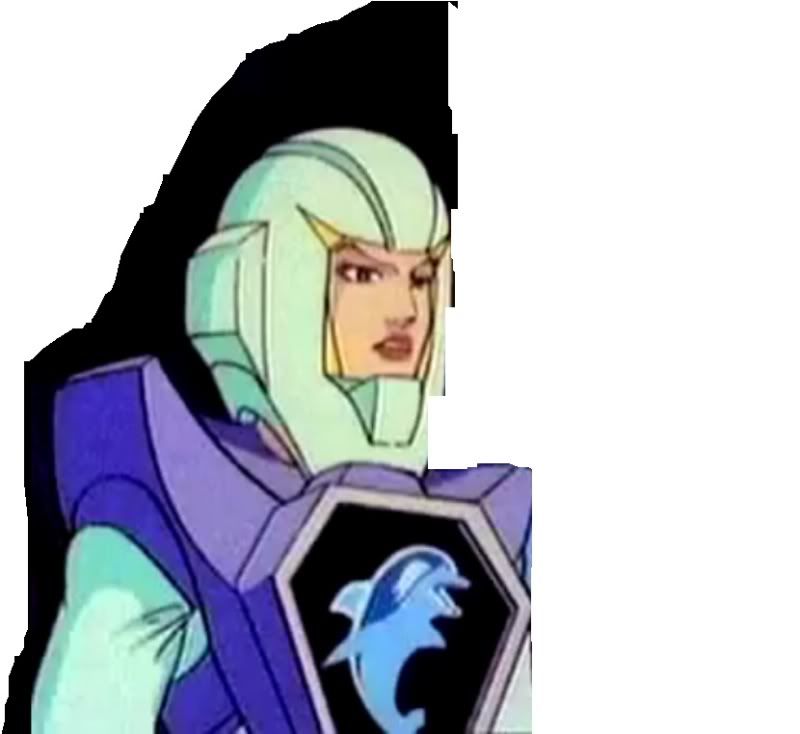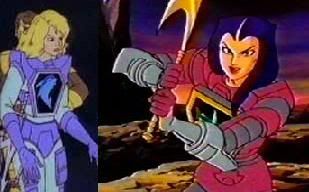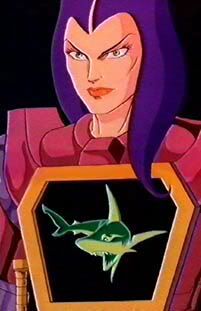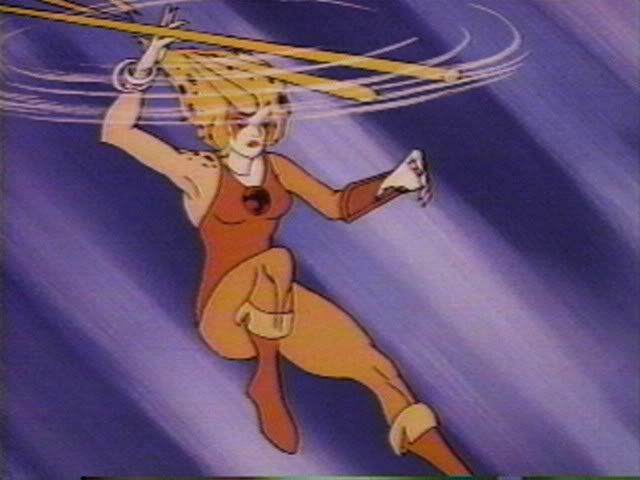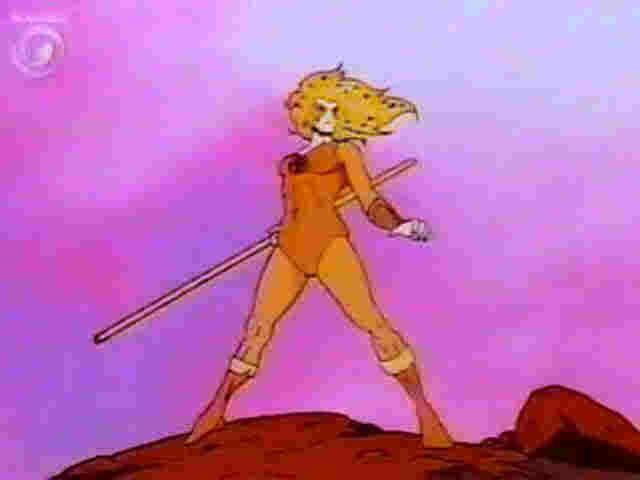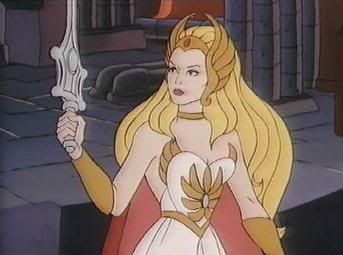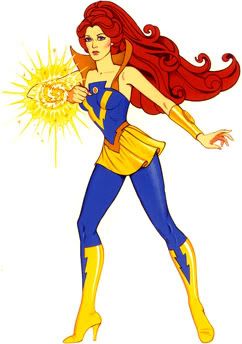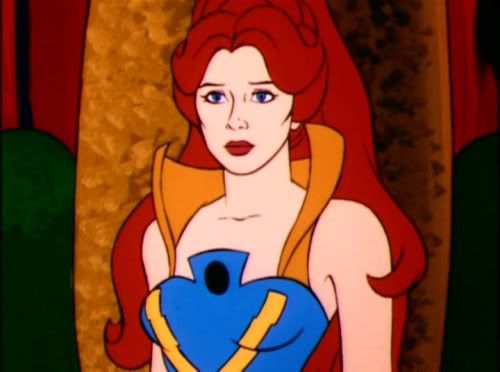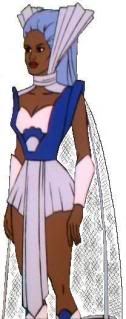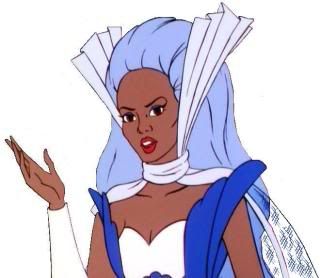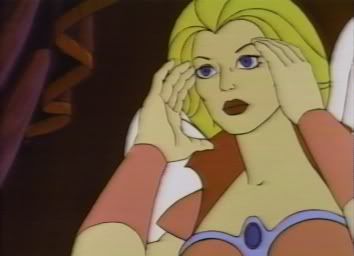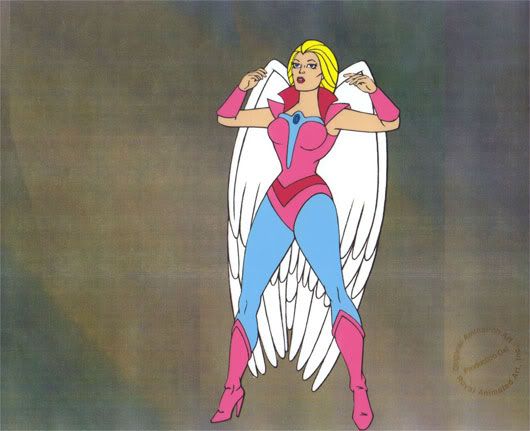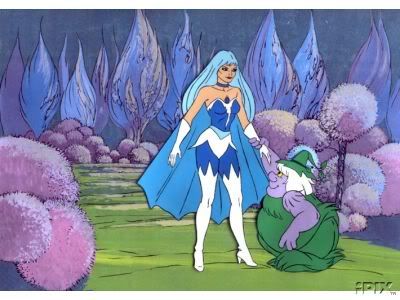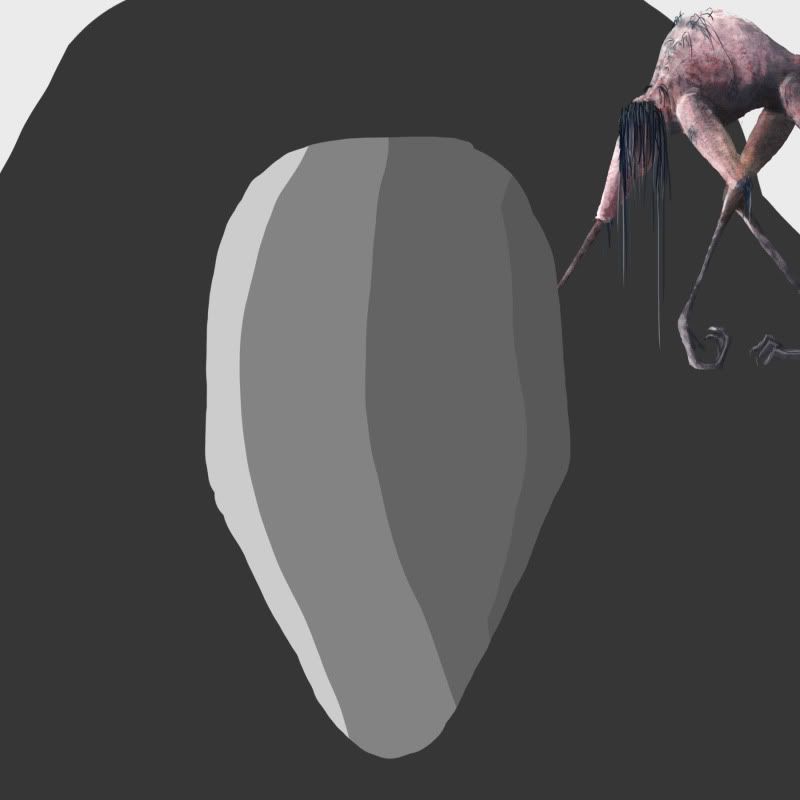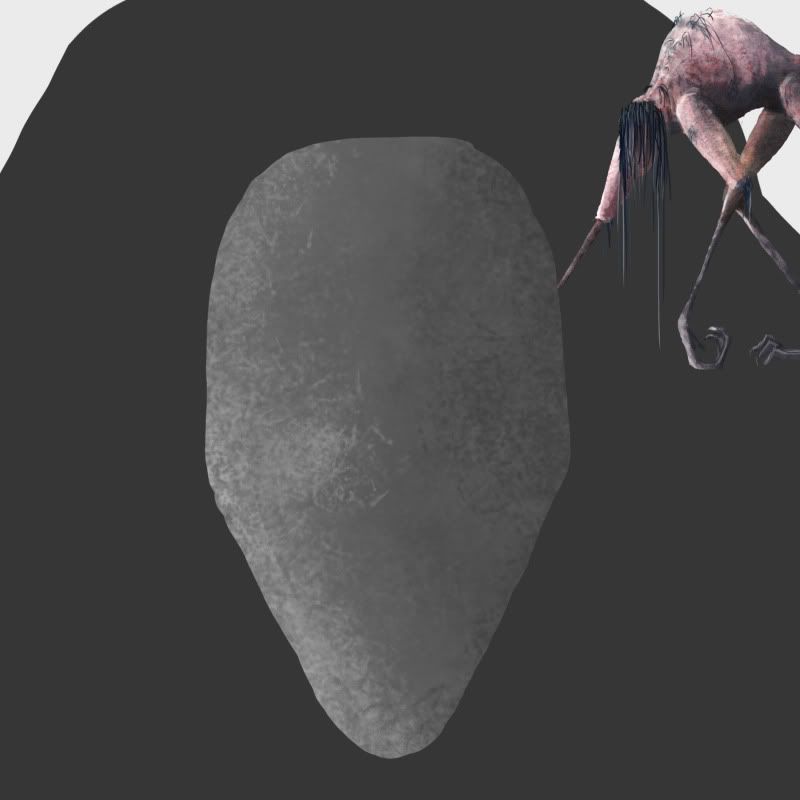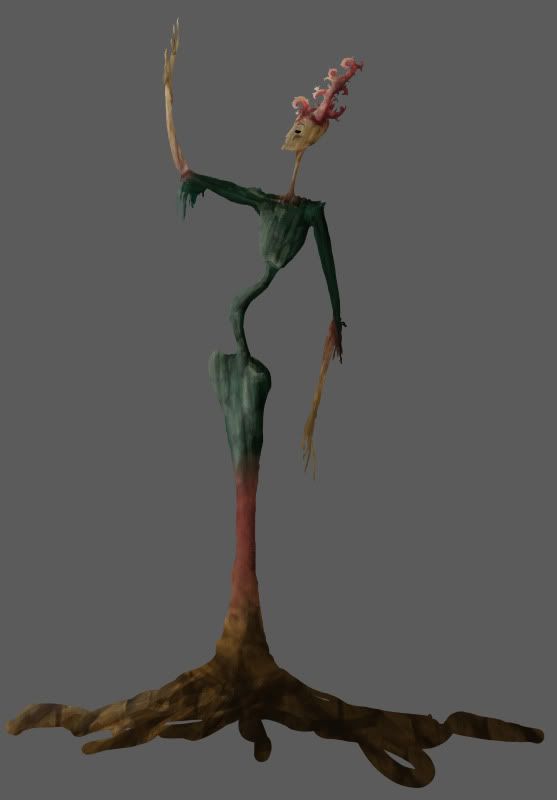My first attempt at lip syncing with the jaw bounce too:
Friday 30 September 2011
Keith Fulton's 'Lost in La Mancha', 2002.
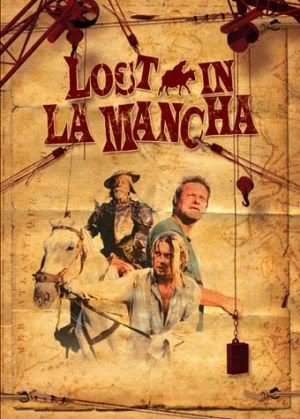 |
| Fig. 1 Poster for Lost in La Mancha |

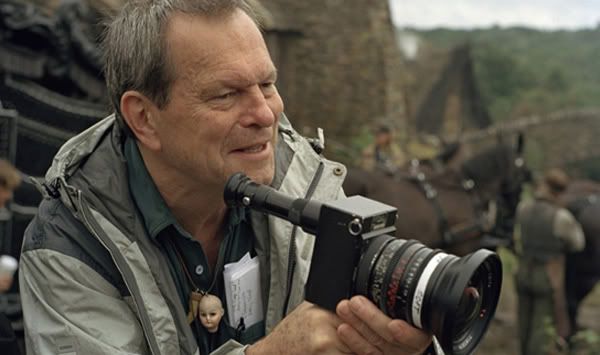 |
| Fig. 2 Image of Terry Gilliam from Lost in La Mancha. |
Despite his previous successes he has been, and is to an extent still is, seen as a very difficult director to work with. Lost in La Mancha is a very successful insight into why some people would perceive him that way. David Morgan revealed "Gilliam's working habits do not travel well. Though he is thorough in preparing films down to the most minute detail, the time it takes to carry those details onto film never matches his hopes." (Morgan, 2004:38) Both the pre-production and production itself of Don Quixote were constantly being set-back by the changes that Gilliam wanted to make. His ambition throughout the making of this film was constantly increasing along with his demands on his crew. In one scene, he describes that he wants a small army of puppet knights, they are produced for him, and then he later decides he needs them changed so the puppets chests can open up and bite the character's arm. It would most likely look great but the constant demands on those that around him takes a toll on the morale. A long time friend of his, Ray Cooper, explains that he's a "responsible enfant terrible" (Lost in La Mancha, 2002), that his passion for his film can lead to unconventional and sometimes shocking behaviour that greatly worries those around him. Gilliam himself describes that Don Quixote is "going to be beautiful and terrible at the same time." (Lost in La Mancha, 2002) and judging from how his production went, it wouldn't be surprising.
Lost in La Mancha shows exactly how stressful and complicated it can be to shoot a film. A whole day can be wasted when trying to move locations, as often Gilliam would be seen chasing sun to try to continue with a scene, only to discover that there's so little time to shoot that they need to either wait until tomorrow or film something else completely. A lot of problems were caused when the majority of their filming materials and equipment were seriously damaged during torrential rain. They had been provided little budget as it was, due to it being filmed entirely by European money, and their insurers were unable to replace the equipment without then losing important filming time. The first assisstant director, Phil Patterson, described it as "absolute and faffing disarray" (Lost in La Mancha, 2002), an accurate description for the stress, the disorganisation and the results of Gilliam's demands on his crew. After seeing the extent to which his ambition and desire to make this film went, it is a real shame it never came to fruition. He entirely desired the best for this film, it could have been a masterpiece, instead it may just act as another black spot on the director's record. Here's hoping for the future.
Lost in La Mancha shows exactly how stressful and complicated it can be to shoot a film. A whole day can be wasted when trying to move locations, as often Gilliam would be seen chasing sun to try to continue with a scene, only to discover that there's so little time to shoot that they need to either wait until tomorrow or film something else completely. A lot of problems were caused when the majority of their filming materials and equipment were seriously damaged during torrential rain. They had been provided little budget as it was, due to it being filmed entirely by European money, and their insurers were unable to replace the equipment without then losing important filming time. The first assisstant director, Phil Patterson, described it as "absolute and faffing disarray" (Lost in La Mancha, 2002), an accurate description for the stress, the disorganisation and the results of Gilliam's demands on his crew. After seeing the extent to which his ambition and desire to make this film went, it is a real shame it never came to fruition. He entirely desired the best for this film, it could have been a masterpiece, instead it may just act as another black spot on the director's record. Here's hoping for the future.
List of Illustrations
Figure 1. Lost in La Mancha (2002) A Poster for Lost in La Mancha. At: http://www.movieposterdb.com/posters/08_02/2002/308514/l_308514_38949097.jpg (Accessed on: 30/09/11)
Figure 1. Lost in La Mancha (2002) A Poster for Lost in La Mancha. At: http://www.movieposterdb.com/posters/08_02/2002/308514/l_308514_38949097.jpg (Accessed on: 30/09/11)
Perry, George (1995) The Life of Python. London: Pavillion Books
Wednesday 28 September 2011
Monday 26 September 2011
Ninja Uniform Research...
Black Belt Magazine: November 1986

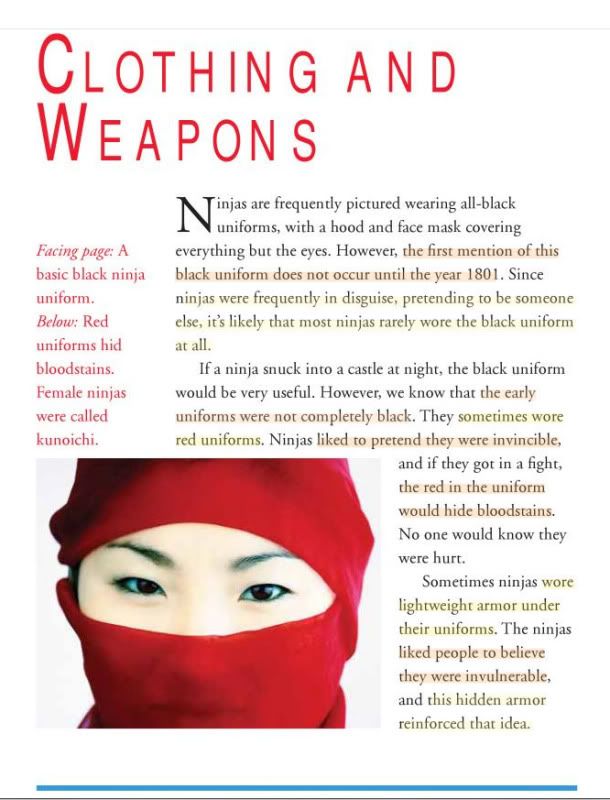
The traditional black ninja uniform was actually called a Shinobi Shozoku, it was the outfit that the prop masters would wear during a Kabuki play so they wouldn't be seen moving parts of the set around. It was a boom in the 80's, I believe, that lead to the all black number becoming popular. The shozoku uniforms normally dark shades of colours, not black, and were useful when the ninjas needed to sneak around somewhere. Generally though, they were purely disguise-based so they would dress in what ever clothes that would make them go unnoticed, such as samurai, peasants or even lords.


The traditional black ninja uniform was actually called a Shinobi Shozoku, it was the outfit that the prop masters would wear during a Kabuki play so they wouldn't be seen moving parts of the set around. It was a boom in the 80's, I believe, that lead to the all black number becoming popular. The shozoku uniforms normally dark shades of colours, not black, and were useful when the ninjas needed to sneak around somewhere. Generally though, they were purely disguise-based so they would dress in what ever clothes that would make them go unnoticed, such as samurai, peasants or even lords.
- Basically they're masters of disguise and deceit, which is great if you add magic and spirits as you get transformative powers :D
Now to actually draw something I feel...
Fantasy Ninja Story Ideas...
After doing some research I've come up with these two rough ideas:
- Demons/Tengu from the Other World are breaking through the barrier between the spirit realm and into our material world, manifesting as powerful means of destruction. Our hero, a kami (spirit from the Other World), has taken it upon themselves to cross over into the material world to rescue it from total chaos.
- Set in the Other World, all is not well with the spirits. One of the more arrogant Tengu has become restless and sought dominance over the spirit world, but one of the Senjin Kami, a mountain dwelling spirit, is taking the journey into the lower depths of the Other World to fight the Tengu and return their home to the peace it once had.
I'm a little stumped as I quite like both of these, but I think I may be leaning more towards the second, even if just because I can have something really fantastical and as the first may end up being a rip off of Samurai Jack :P
Now I think it's probably time to look into how fantastical the world could be and what my characters may actually look like, so...Onwards! :D
Myth and The Movies...
This was one of the books recommended by Alan in our brief and it's been a really great source for narratives in particular genres.
Here are the notes I've made from it:
There are 3 types of story to the horror and science fiction/fantasy genres. In horror these are:
The stories in Science Fiction and Fantasy genre are:
Here are the notes I've made from it:
There are 3 types of story to the horror and science fiction/fantasy genres. In horror these are:
- "Man battles an outside monster that has come to pay a visit."
- These include demons, vampires, diseases, aliens, monster sharks e.g. Invasion of the Body Snatchers, Jaws.
- "Man creates the monster, seemingly with good intentions, that gets out of hand and must be destroyed."
- These include genetic experimentation and inventions that turn disastrous e.g. The Fly.
- "Man is monster."
- These address the wickedness of man.
- Man confronts the dark side of his nature.
- Hero faces the shadow within himself or the evil may be personified or externalised e.g. Halloween, Silence of the Lambs.
"Each of these stories provides a central thrust of action that propels us to the end of the film. Horror thrills aren't enough to make a successful film, those terrifying sequences need to be structured around the central action."
The stories in Science Fiction and Fantasy genre are:
- "An Ordinary Hero enters a fantastic world."
- An imaginary/fabled world e.g. Alice in Wonderland, Wizard of Oz
- Lost civilisation based on earthly reality is found e.g. Journey to the Centre of the Earth, the Lost World.
- The Hero finds a portal/makes a time machine e.g. Back to the Future, Time Bandits.
- "A fantastic being enters the Hero's Ordinary World."
- The creature is stuck, the films journey is its safe return e.g. E.T
- The creature arrives with a quest e.g. Terminator 2, War of the Worlds
- It arrives to pull the hero into its world e.g. Close Encounter of the Third Kind, Invasion of the Body Snatchers.
- "The Hero exists within a fantastic Ordinary World armed with awareness of its Science and mythology."
- The hero needs to solve a problem and great adventures follow e.g. Star Wars films
- Quest Journey shows the hero being manipulated by a greater power, such as gods/fate/magic e.g. Jason and the Argonauts, the Sinbad films.
- These can involve space travel adventures e.g. 2001: A Space Odyssey.
Voytilla, Stuart (1999) Myth and the Movies: Discovering the Mythic Structure of 50 Unforgettable Films. Canada: Michael Wiese Productions. Pages 75 and 261.
It's a great guide to help with both projects really, so I intend on popping back to this and getting ideas a lot! :P
Research into Kami and Japanese Mythology...
I was sent a link from Phil and Chris that was super helpful when it comes to Japanese mythology. I'm a bit stumped for where to start researching so being pointed towards these spirits called Kami is a great help.
The link was for a programme on BBC iPlayer from Radio 4, and it was about the history of Shinto, a belief system that tries to match up to the religion of Buddhism. It has no particular deity that people come to worship at its shrine, instead there are multiple spirits called Kami that they come to pray to and appease. Kami are in no way concerned with the material world we live in, but they do enjoy being 'fed' and worshipped. These Kami are spirits of nature, they manifest in our material world as forces of nature, such as natural disasters, whenever they please because they are amoral and indifferent to us. These spirits are incredibly prideful and easily offended, they can be appeased with offerings but they have no real desire to act out any divine intervention that would benefit humanity.
After looking into Kami I've found a lot of useful information on them and other Japanese deities:
"Atsutane asked, “What’s the difference between demons and tengu, and where do the demons live?” ..."They are always flying around in the sky and causing calamities in the world. That is, if a person is evil, they increase the evil, and if the person is good, they obstruct his good deeds and cause evil thoughts to arise within him. They seek out the vanity and laziness in people and prey on those thoughts to bring about all kinds of calamities and disasters. They pervert people’s thoughts toward evil things. They deceive humans by manifesting themselves in shapes and appearances that would appeal to each person. They can change into anything: buddhas, bodhisattvas, handsome men, beautiful women, and apparitions from hell or paradise... The demons I have seen with my own eyes look like the ones in the accompanying pictures. The one moving the cart is called a dairiki [great power]. These are not the only two types but these are the types of demons that I clearly remember seeing. I don’t know the name of the other demon drawn here. I drew him as I saw him, with chains hanging from his ears. Strings hang from the hands of the demons and they lower them to cause disaster to strike whatever they touch. In addition, they seem to have fur on their heads that looks more like iron needles. They pull on the strings hanging from their hands, but they can’t catch good people with them. Also, they walk around peeking into people’s houses. These demons are infested with horseflies. Also, there are some demons that have skulls for heads. One of the reasons that kami exist is to rescue humans from all these kinds of demons running around.
This was Torakichi’s most detailed statement on demons, and some of the extant pictures show precisely what kind of beasts he was describing. Their reason for existence seemed to be to destroy good and spread evil. While Torakichi claimed there was a certain amount of protection from demons provided by strong moral character, he also insisted that demons could cause evil thoughts even among the good. Although their natural appearance was ugly, scary, and dangerous, they also had shape-shifting abilities. In other words, anything could be a demon in disguise. "
"The bulk of the information given by Torakichi about the inhabitants of the Other World concerns beings that fit into two categories: the tengu and the mountain-dwelling humans, referred to as sanjin. Even so, Torakichi often collapsed the categories; for example, he sometimes called sanjin kami, called demons tengu, and used the terms sanjin and tengu interchangeably. In particular, when it came to the term tengu, Torakichi often used it as a positive appellation meant to bestow a good and powerful status on his master."
On using the term tengu for real historical figures:
"The ones with the bad reputations were tengu, and the ones with the good reputations were sanjin. At least this was the dichotomy on which Atsutane was relying to distinguish the supernatural figure he intended to praise."
Hansen, Wilburn. (2008) When Tengu Talk : Hirata Atsutane's Ethnography of the Other World. Hawaii: University of Hawaii Press. Page 76-78, 81
The link was for a programme on BBC iPlayer from Radio 4, and it was about the history of Shinto, a belief system that tries to match up to the religion of Buddhism. It has no particular deity that people come to worship at its shrine, instead there are multiple spirits called Kami that they come to pray to and appease. Kami are in no way concerned with the material world we live in, but they do enjoy being 'fed' and worshipped. These Kami are spirits of nature, they manifest in our material world as forces of nature, such as natural disasters, whenever they please because they are amoral and indifferent to us. These spirits are incredibly prideful and easily offended, they can be appeased with offerings but they have no real desire to act out any divine intervention that would benefit humanity.
After looking into Kami I've found a lot of useful information on them and other Japanese deities:
"Atsutane asked, “What’s the difference between demons and tengu, and where do the demons live?” ..."They are always flying around in the sky and causing calamities in the world. That is, if a person is evil, they increase the evil, and if the person is good, they obstruct his good deeds and cause evil thoughts to arise within him. They seek out the vanity and laziness in people and prey on those thoughts to bring about all kinds of calamities and disasters. They pervert people’s thoughts toward evil things. They deceive humans by manifesting themselves in shapes and appearances that would appeal to each person. They can change into anything: buddhas, bodhisattvas, handsome men, beautiful women, and apparitions from hell or paradise... The demons I have seen with my own eyes look like the ones in the accompanying pictures. The one moving the cart is called a dairiki [great power]. These are not the only two types but these are the types of demons that I clearly remember seeing. I don’t know the name of the other demon drawn here. I drew him as I saw him, with chains hanging from his ears. Strings hang from the hands of the demons and they lower them to cause disaster to strike whatever they touch. In addition, they seem to have fur on their heads that looks more like iron needles. They pull on the strings hanging from their hands, but they can’t catch good people with them. Also, they walk around peeking into people’s houses. These demons are infested with horseflies. Also, there are some demons that have skulls for heads. One of the reasons that kami exist is to rescue humans from all these kinds of demons running around.
This was Torakichi’s most detailed statement on demons, and some of the extant pictures show precisely what kind of beasts he was describing. Their reason for existence seemed to be to destroy good and spread evil. While Torakichi claimed there was a certain amount of protection from demons provided by strong moral character, he also insisted that demons could cause evil thoughts even among the good. Although their natural appearance was ugly, scary, and dangerous, they also had shape-shifting abilities. In other words, anything could be a demon in disguise. "
"The bulk of the information given by Torakichi about the inhabitants of the Other World concerns beings that fit into two categories: the tengu and the mountain-dwelling humans, referred to as sanjin. Even so, Torakichi often collapsed the categories; for example, he sometimes called sanjin kami, called demons tengu, and used the terms sanjin and tengu interchangeably. In particular, when it came to the term tengu, Torakichi often used it as a positive appellation meant to bestow a good and powerful status on his master."
On using the term tengu for real historical figures:
"The ones with the bad reputations were tengu, and the ones with the good reputations were sanjin. At least this was the dichotomy on which Atsutane was relying to distinguish the supernatural figure he intended to praise."
Hansen, Wilburn. (2008) When Tengu Talk : Hirata Atsutane's Ethnography of the Other World. Hawaii: University of Hawaii Press. Page 76-78, 81
Now this is as helpful as it is confusing. I've learnt that the words tengu, sanjin and kami are often used interchangeably, and because of this I'm not entirely sure which to use for what when it comes to my story. However! This dilemma can also be seen as allowing me to choose which I want to use in a negative and positive light, which is very nice indeed. So, time to make some decisions!
First Notes on Fantasy Ninja Character Ideas...
A lot has changed since I made these but I want them to be up there in case there's something that may help later:
- Ninjas with magic - Teleportation, stealth/invisibility.
- Female hero.
- Are there dragons? If so, what kind and are they tame or something the characters have conflict with?
- If they have magic, do they have spells like fireballs or is it strictly to aid them hiding in the shadows?
- Is the world hidden within our material world, deep inside the forests (like a mystical version of Poddington Peas) or is theirs completely separate to ours (like the Kami)?
- Ninjas are the good guys, would the villains be ninjas also but with opposite moral values?
- Are they physically different due to their corruption or perhaps they're different species.
- Is it a case that a ninja has gone rogue and taken it upon themselves to wreak havoc on the world?
- The world they live in needs rules as they allow for more accurate representation of the character's abilities and explanation.
- Research wise: Look into Samurai Jack, see how they've adapted Japanese mythology to portray these characters and their environments.
- Research into Japanese mythology, history of ninjutsu, any folklore or common themes within them.
- Look into their uniforms. Is it normally the all black outfit or is that a western misconception?
- Following this look into the 80's style clothing and combine them accordingly.
- Colouring: Deep purples/blues for the 'good' ninjas, maybe a strip of colour like TMNT. Villains could perhaps have quite garish colours to show they're unafraid of being seen, such as greens or purples depending on final hero ideas.
Research into Kami (thank you Phil and Chris! :D) and everything else mentioned will be up soon! :)
Character Design: My Futuristic Football Hooligan...
For our first activity in character design I had to have a go at drawing a futuristic football hooligan:
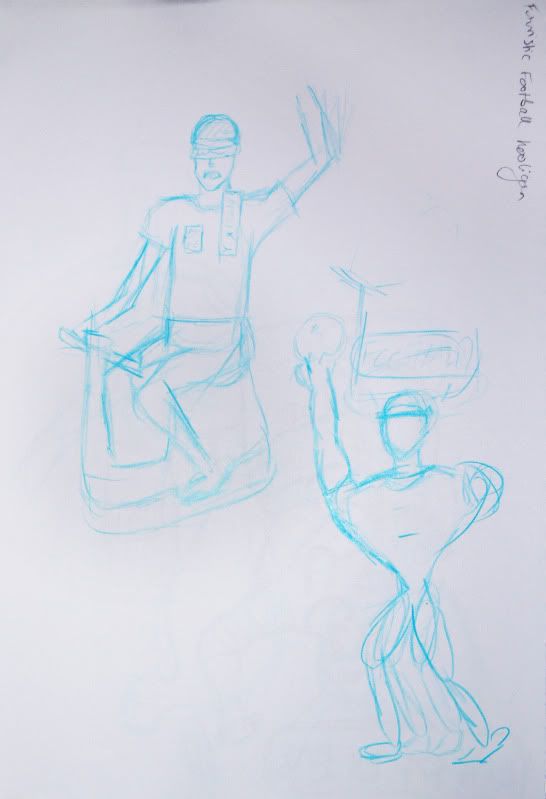

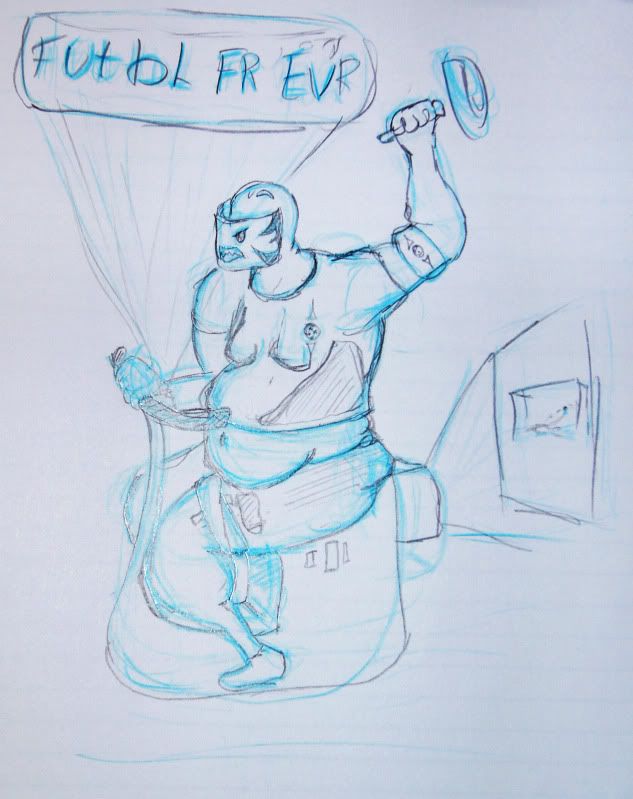



I drew a serious blank when I got this character (as you can see by my rubbish first attempt at the top left) but after Justin helped me, my final fat, hologram-loving, hover-scootering hooligan didn't turn out so bad! :D
Saturday 24 September 2011
Quentin Tarantino's 'Kill Bill: Vol. 1', 2003
 |
| Fig. 1 Kill Bill: Vol. 1 Poster |

Kill Bill: Vol. 1 is a wonderful example of how the postmodern approach of taking influences from pre-existing material and combining it for your own needs can create something unique. A plethora of martial arts and western genre film references welcomes the audience into the world of the director, Quentin Tarantino.
 |
| Fig. 2 Screenshot of direct visual reference. |
Tarantino is a real lover of film and its visual storytelling. Kill Bill's extensive borrowing of techniques from other existing films either visually or musically, is proof of this. As Dominique Mainon and James Ursini explain: "one cannot help but feel that the film was ultimately made primarily for Tarantino's own viewing pleasure, with the audience of secondary concern." (Mainon, Ursini, 2006:206) There are so many films referenced that are both mainstream and niche that it can feel to the viewer that his films are solely designed for him to enjoy at the expense of good narrative and depth, but Mainon and Ursini go on to say that despite this "it is easy to be drawn into it. Tarantino's universe is a frenetically paced world with all the trappings of a fourteen-year-old boy's adventure fantasy, a psychological counselling session, and a manic pop culture/media experiment" (Mainon, Ursini, 2006:206). Kill Bill: Vol. 1 certainly has the frenetic energy they mention. It is seen through the quite spectacular jumping between different intertextual references, such as The Bride's biker outfit 'taken' from Bruce Lee's The Game of Death to a fight sequence mirroring one from Samurai Fiction.
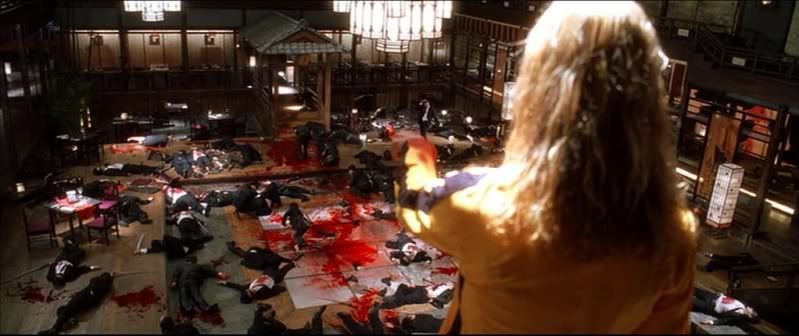 |
| Fig. 3 The Bride destroys O-Ren's henchmen. |
The fight sequences displayed in Kill Bill are incredibly frenetic but also vicious, bloody and gory. One of the most interesting aspects of these gory fight scenes is that all this vengeful killing is done by a female lead, and the victims she confronts from her list, for this film at least, are all also female. Diane Negra and Yvonne Tasker believe that the "Intense bloodshed in Kill Bill is reserved for female opponents, and each of the personally motivated battles occurs within enclosed, domestic, or at the very least quiet and incongruous spaces for violence... Varied in tone, theme, narrational style, and context, all of these fight scenes are defined by the strong kinetic action of the heroine." (Negra, Tasker, 2007:160) The violence within this film is often considered gratuitous, the use of a female lead is usually to act as added titillation to the violence, but in Kill Bill Tarantino is deliberately drawing the audience's attention to this. One of the most interesting themes in these films is that the heroine is acting as the hero seeking revenge and it isn't until she's immobilised that she becomes overtly sexualised by the men around her. Negra and Tasker go on to express that "Kill Bill foregrounds violence and gender, doing so in a way that emphasizes its own commodification, stylistic extravagance, superficiality, and cultural appropriation... the film offers a spectacle of gender and aestheticized violence that simultaneously deflects and invites or provokes our critical attention to its discourses of gender" (Negra, Tasker, 2007:154) Tarantino has deliberately taken the stereotypes and clichés that are associated with violence and the women that either endure or dispense it, and used them to challenge the audience's belief. He wants them to see that these old, exploitative themes, when seen from someone else's view, can actually be challenging and quite stylised spectacle.
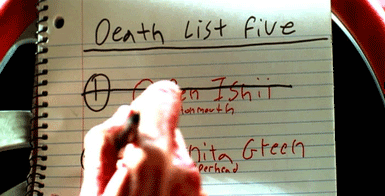 |
| Fig.4 The Bride's Death List. |
It isn't just the use of violence and stereotypes that Tarantino wants to employ to create an interesting narrative either. M. Keith Brooker explains that the Kill Bill films "are not about violence, but about movies; they are really about their own making - and the making of films in general." (Brooker, 2007:93) Tarantino is also well known for using many different techniques when making his films, and one of these is the non-linear narrative. The film begins by telling the audience that one of The Bride's targets is already dead, and we go on to watch her kill the second. Of course we go back to see her first victim, by doing so Tarantino can make a fairly ordinary story of revenge feel fresh and much more interesting to the audience. Not only do we have the non-linear narrative, showing us only certain elements of the story, but there are titles used in order to divide it further. Philip John Gillett construed that "The flashback structure makes events difficult to follow, yet by dividing the narrative with inter-titles which place events in a time sequence, Tarantino is indicating that the story cannot be dismissed in favour of the excitement of the moment." (Gillett, 2008:Section 16) Tarantino wants the audience to be completely under his control, they can only see what he wants them to see, when he wants them to see it. This technique means that the audience can't predict what will happen next, allowing for the director to keep them enthralled by a fight sequence one moment and then by a character's origin story the next.
Kill Bill: Vol. 1 is, on paper, a simple story of revenge, but in reality it is a postmodern journey into the realms of extreme intertextuality. The audience gets stylised violence, beautiful visual language and a fantastic soundtrack. Brooker describes it as "if Pulp Fiction remains the best film by Tarantino, the Kill Bill films are clearly the films that best represent Tarantino's special traits as a filmmaker." (Brooker, 2007:94) This is exactly that. Kill Bill shows how elegantly Tarantino can visually portray influences and references from the genres he loves so dearly.
List of Illustrations
Figure 1. Kill Bill: Vol.1 poster (2003) At: http://www.movieposterdb.com/posters/05_02/2003/0266697/l_8175_0266697_4af8c109.jpg (Accessed on: 24.09.11)
Figure 2. Screenshot of direct visual reference (2003) At: http://designyoutrust.com/wp-content/uploads/2011/05/Everything-Is-A-Remix-KILL-BILL-1-600x335.png (Accessed on: 24.09.11)
Figure 3. The Bride destroys O-Ren's henchmen (2003) At: http://filmjournal.net/mjocallaghan/files/2007/07/killbill1.jpg (Accessed on: 24.09.11)
Figure 4. The Bride's Death List (2003) At: http://media.tumblr.com/tumblr_lqd0dqL3Z91qkl8dr.gif (Accessed on: 24.09.11)
Bibliography
Booker, M. Keith (2007) Postmodern Hollywood: what's new in film and why it makes us feel so strange. USA: Praeger Publishers.
Gillett, Philip John (2008) Movie greats: a critical study of classic cinema. New York: Berg Editorial offices.
Mainon, Dominique, Ursini, James (2006) Modern Amazons: warrior women on screen. New Jersey: Limelight Editions.
Negra, Diane, Tasker, Yvonne (2007) Interrogating postfeminism: gender and the politics of popular culture. USA: Duke University Press.
Tarantino's References:
Friday 23 September 2011
Tim Burton's 'Ed Wood' (1994)
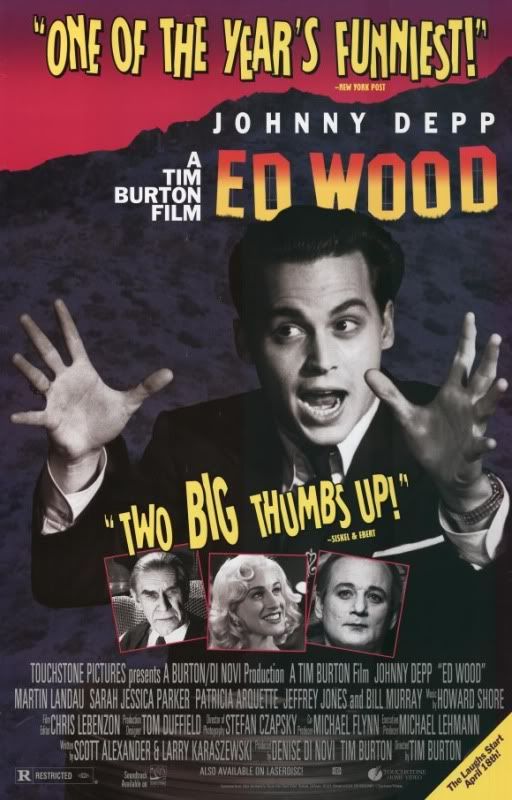 |
| Fig. 1 Ed Wood Film poster |
Ed Wood is a charming film that is as authentic as it is enjoyable. The film itself is a biopic about a film director of the same name, who's most famous for being voted the 'Worst Director of All Time'. His films have received cult status due to their unconventional narratives, poor special effects and scripting, leading them to be scathed by critics but enjoyed by fans of Edward D. Wood's passion to make what he loves.
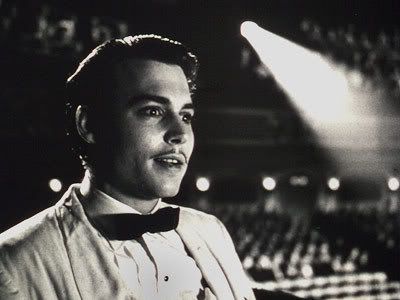 |
| Fig. 2 Edward D. Wood Jr. |
The director, Tim Burton, is well known for his love of 1950's B-Movies. They are films with so little budget that the director can only hold them together with his passion for them and it is this passion that the director portrayed so strongly in his depiction of Ed Wood. As Steve Erickson describes "Wood's passion for movies isn't a frame less ferocious than Orson Welles's" (Erickson, 2005:84) and this is no more clear than in a sequence where Ed Wood meets Orson Welles himself. They both have the same passion, the same problems with their studios, it's just that Ed Wood has a lot less talent when it comes to writing, directing and acting than Welles does. Despite his complete lack of directorial skill, the scathing reviews he receives from critics and the public, he still keeps on pushing his visions forward. In the film he has such a blind love for making movies that he can't see how flawed his films are or how they are being recieved. Erickson goes on to explain that "Ed Wood may be a fool in the way his sense of wonder and his love of movies exceed his talent, but he's too lacking in cynicism to be a hack; he believes in his dreams and even converts a world to them by the force of his belief, however ineptly he fulfills those dreams and however short of his dreams the dreamer falls." (Erickson, 2005:84) It is this that makes the film and character so charming. Granted, the film may be more of a love letter to the director, brushing over any of Wood's negative traits, but his portrayal in the film is full of passion and innocence, naivety and honesty. He's child-like in his disregard for other people's opinions, bearing all and feeling unashamed at doing so, even if just because the characters around him are just as unusual as he is.
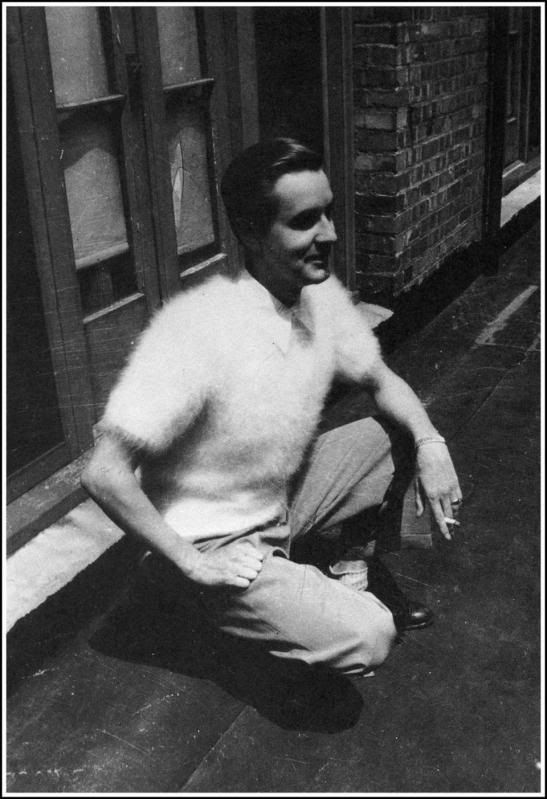 |
| Fig. 3 Wood directing. |
Something very unique and quite impressively revealing is Wood's enjoyment of wearing womens clothes. In the film the audience is shown his insecurity about revealing it but his complete freedom once he has. His very first feature film called Glen or Glenda? (1953) is depicted in Ed Wood as a pivotal moment in his life as it is part of what earns him the directors seat for his first film. Rob Craig expressed that Glen or Glenda? was "an extraordinary, deeply personal polemic which pleaded tolerance of difference while cannily addressing some salient social issues of the guilt-ridden, soul-searching postwar era." (Craig, 2009:23) It is clear to see the difficulties that this realisation would have had during this era. Ed Wood is a stunning example of creating an authentic period film, even using black and white footage. It is authentic right down to the attitudes towards sexuality and societal roles, which allows the audience to see exactly how brave Edward Wood is to confess to something that would normally label him a 'fruit'. His honesty with his later girlfriend and her acceptance of it in Ed Wood is refreshing even by modern standards, and the audience can't help but feel that no matter how bad Glen or Glenda? is as a movie, it is still a very brave and modern narrative in a time when to be a man was a very strict stereotype.
Ed Wood was a thoroughly enjoyable, gorgeously produced film that sits perfectly in the period it was set. Mirroring Wood's own line on the late Bela Lugosi's appearance in Plan 9 From Outer Space (1959): "here was a bonafide cultural hero brought to vivid, implausible life through the magic of motion pictures." (Craig, 2009:277). Much like Bela, Edward D. Wood was resurrected by Tim Burton in the medium that he so loved. Though Wood may have been troubled, and failed to receive the success he so richly desired, it was clear that he was doing what he loved, no matter how patchy or flawed his visions may have been.
List of Illustrations
Figure 1. Ed Wood film poster (1994) At: http://www.joblo.com/movie-posters/ed-wood-02 (Accessed on: 24.09.11)
Figure 2. Edward D. Wood Jr. (1994) At: http://www.testq.com/nfs/testq/photos/0000/9513/Johnny-Depp-Ed-Wood_l_max600.jpg?1270754595 (Accessed on: 24.09.11)
Figure 3. Wood Directing At: http://8.asset.soup.io/asset/0515/7848_e428_960.jpeg (Accessed on: 24.09.11)
Bibliography
Erickson, S (2005) American Innocent: Johnny Depp is the man of our dreams. In: Los Angeles Magazine Jan 2005 pp.82-85
Craig, Rob (2009) Ed Wood, mad genius: a critical study of the films. North Carolina: McFarland & Company, Inc.
Figure 2. Edward D. Wood Jr. (1994) At: http://www.testq.com/nfs/testq/photos/0000/9513/Johnny-Depp-Ed-Wood_l_max600.jpg?1270754595 (Accessed on: 24.09.11)
Figure 3. Wood Directing At: http://8.asset.soup.io/asset/0515/7848_e428_960.jpeg (Accessed on: 24.09.11)
Bibliography
Erickson, S (2005) American Innocent: Johnny Depp is the man of our dreams. In: Los Angeles Magazine Jan 2005 pp.82-85
Craig, Rob (2009) Ed Wood, mad genius: a critical study of the films. North Carolina: McFarland & Company, Inc.
Edward D. Wood Trailers:
Thursday 22 September 2011
80's Cartoon Research...
So many amazing theme songs, so little time! Here are a few of the cartoons I'd like to use as reference later:
Visionaries:
Thundercats:
http://www.youtube.com/watch?v=CjaTkPYzK00 (can't embed)
Teenage Mutant Ninja Turtles:
http://www.youtube.com/watch?v=Gn5iCn_T68c (Can't embed)
She-Ra:
Castaspella:
Netossa:
Queen Angella:
Glimmer:
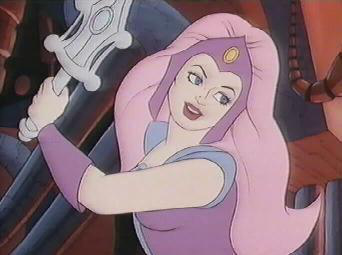

Frosta:
He-Man:
Dungeons & Dragons:
Visionaries:
- One female knight named Galadria.
- Her Nemesis is named Virulina, who is considered a much more interesting character.
Thundercats:
http://www.youtube.com/watch?v=CjaTkPYzK00 (can't embed)
- Cheetara is the only adult female of the Thundercats.
- She's seen to be as caring as she is brave.
- A physically fit, strong and fast character.
Teenage Mutant Ninja Turtles:
http://www.youtube.com/watch?v=Gn5iCn_T68c (Can't embed)
She-Ra:
Castaspella:
Netossa:
Queen Angella:
Glimmer:


Frosta:
He-Man:
Dungeons & Dragons:
Some of these will be used for character ideas, narrative and some I just like as reference on this subject. Lots of good stuff though! :D
Wednesday 21 September 2011
Character Design: Fantasy Ninjas! *Repeatedly Updated*
Well I was pretty unexcited at drawing these two words from the pack, until I realised that to have 'fantasy' as a description means it's pretty much open to any interpretation. This is very exciting indeed so onwards to some research and ideas:
- One thing that I'd quite like to have is a strong female hero. After looking at the images of Pocahontas and Wonder Woman, I think having a physically amd emotionally strong female lead would be really great.
Ninja Research:
- Tengu are Japanese demons that can be both evil and beneficial. Usually with large noses wings and clawed hands, they are also said to have trained ninjas/shinobi.
- The ryu of ninjutsu are schools usually with legendary foundation stories.
- Ninjutsu was founded by Kain Doshi and Daisuke Togakure:
- It was first formalized by Daisuke Togakure and Kain Doshi:
- Super useful book about the history of ninjas: Ninja: The Shadow Warrior by Joel Levy
More soon...
Friday 16 September 2011
Wednesday 14 September 2011
The Collector's Face Part One...
I thought I'd just give it a go as I was REALLY unsure what to go with so this is how it went:
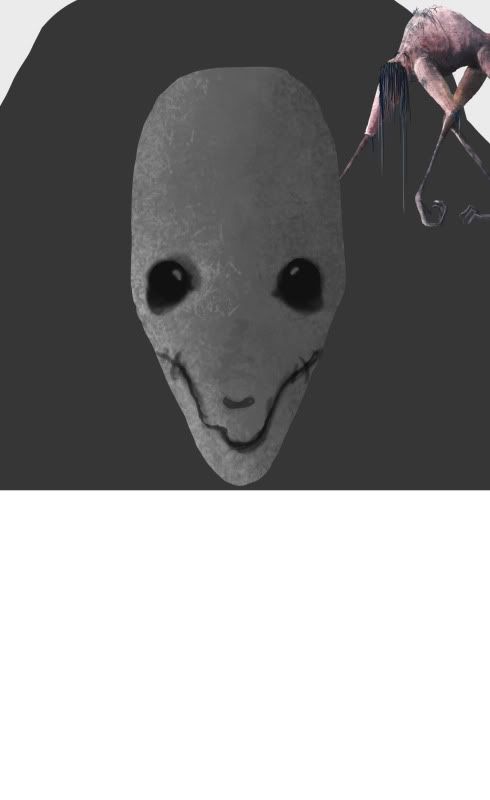

I think it's almost right. I like the idea of it looking like a sort of half-humanoid half-animal so I think from the side it'll have a flat nose much like a ram or goat. I'm trying to keep the skin tone looking like it was once healthy but it's starting to rot away and fester, which isn't quite portrayed yet but it'll get there :P
Also, the eyes are meant to look sunken and I want them to be like deep dark pits that sparkle beneath the hair, so that'll need some work too. Generally good though, I think it's suitably unsettling but any feedback or suggestions are much appreciated!
The leather stitched together skin is on its way, I've been working on it a little but it's not really looking like much so that'll have to be a future post :)


Also, the eyes are meant to look sunken and I want them to be like deep dark pits that sparkle beneath the hair, so that'll need some work too. Generally good though, I think it's suitably unsettling but any feedback or suggestions are much appreciated!
The leather stitched together skin is on its way, I've been working on it a little but it's not really looking like much so that'll have to be a future post :)
A Little Update...
Just a smidge of work on Ursula again. Her hips are much better here than they were previously (see below):

A quick look at the silhouette, which I think works quite nicely and was definitely improved by looking at Erte's dynamically posed illustrations.
I've let myself get very lax when it comes to work the last week or so as the boyfriend's finally returned from his 4 months away. However, while he's out for the evening I'm going to see what I can get done on the collector! :D
Subscribe to:
Posts (Atom)

